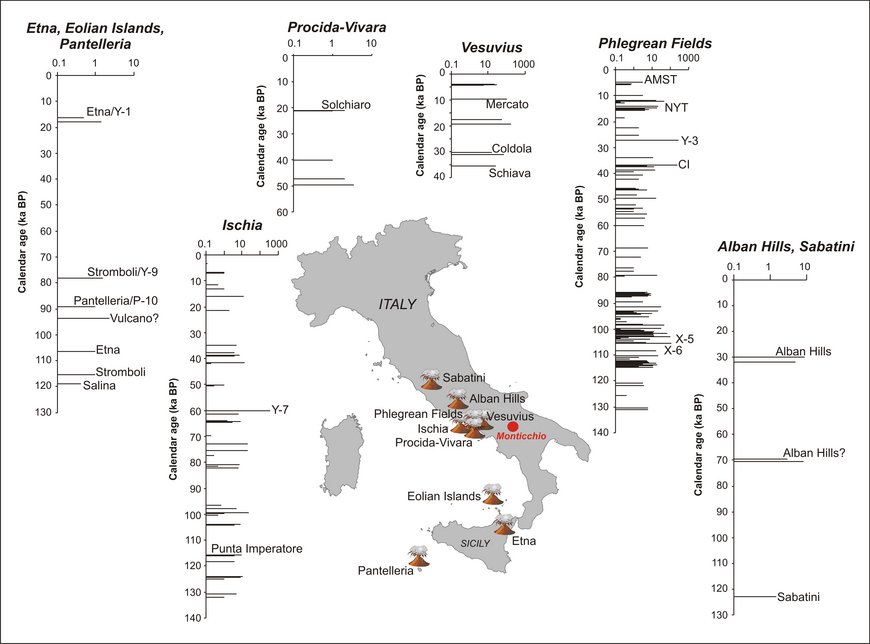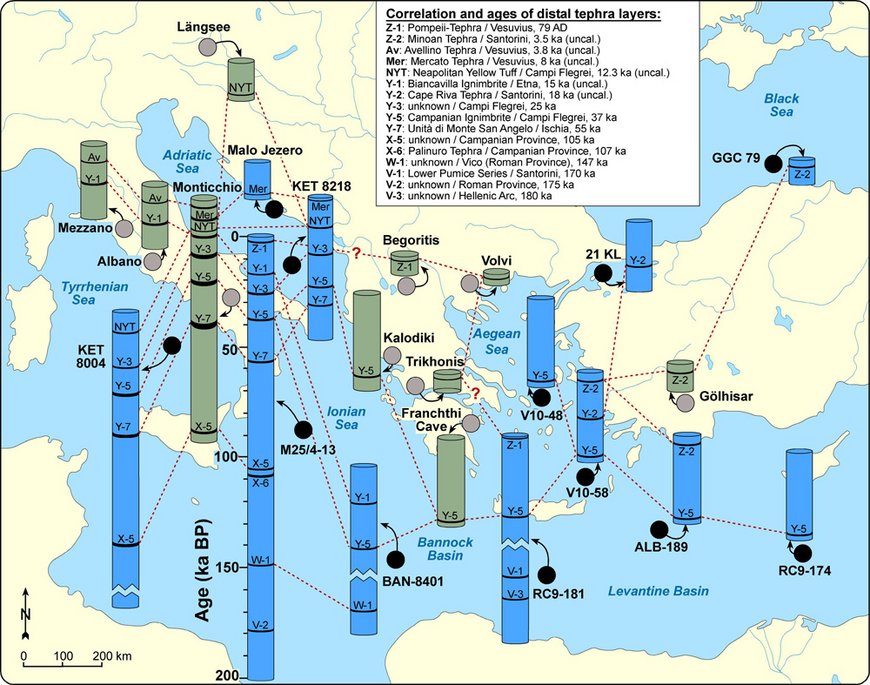Tephrochronology of the 133 ka sediment record of Lago Grande di Monticchio



Laminated sediments recovered from the maar lake Lago Grande di Monticchio in southern Italy not only provide detailed information about the regional climatic and environmental development but also about the explosive activity of nearby (100-540 km) Quaternary Italian volcanoes. A total of 345 distal tephra layers are intercalated in the sediments of the 133 ka Monticchio record. Based on the geochemical fingerprints of volcanic glass shards as well as the mineralogical-lithic composition and stratigraphic position of ash layers most of these tephras could be attributed to the still active K-alkaline volcanoes of the Campanian Province (e.g. Vesuvius, Phlegrean Fields, Ischia), which represents an area of high volcanic risk for Naples and its surrounding towns. Other tephra layers were related to high-explosive events of K-alkaline Roman (e.g. Alban Hill, Sabatini Volcanic District) and calc-alkaline to Na-alkaline Sicilian-Aeolian volcanoes (e.g. Mt. Etna, Stromboli, Salina, Volcano, Pantelleria Island). These findings provide new information about the explosive history of Italian volcanoes and the distribution of emitted tephra. Thus the detection of several tephras like, for instance, the Interplinian “AP” tephras from Vesuvius (ca. 3.5 ka BP) or the Solchiaro tephra from Procida-Vivara (22 ka BP) proved a wider distribution of eruption tephra material than previously proposed. Moreover, numerous older tephra events (i.e. the widespread X-6 tephra, 108.3 ka BP) were dated for the first time by the Monticchio varve and sedimentation rate chronology. For some of the larger events the rapid succession of eruptions within a short time is clearly recorded in the Monticchio record due to the high sedimentation rate and absence of sediment mixing due to bioturbation or subaqueous currents.
A total of 28 radiometric tephra ages obtained from proximal and distal equivalents were furthermore used to support the age model of Monticchio sediments.
Thus the tephrostratigraphic profile of Monticchio plays a key role for the dating and linking with other terrestrial and marine palaeoclimate records in the Mediterranean facilitating the interpretation of the timing and order of climate processes (“leads and lags”).
Partner
J. Keller (former Albert-Ludwigs-Universität Freiburg i.Br.), M. McKenzie and P. Albert (Royal Holloway University of London, UK), E. Tomlinson (Trinity College Dublin, Irland), B. Giaccio (CNR Rom, Italien), R. Sulpizio (Universitá di Bari, Italien)
Tephrochronological methods
Tephra (volcanic ash) encompasses airborne material from explosive volcanic eruptions that can be dispersed by wind and deposited over large areas more or less synchronously. Despite its destructive nature, tephras are of great use in terms of independently dating and synchronizing different environments (land, ocean, ice). If deposited in sedimentary sites relatively close to the volcanic source, tephras can be easily detected as discrete visible layers. In further distal archives, however, only traces of tephras – often a lower number of fine grained (< 100 microns) volcanic glass shards – can be found due to sorting processes during the aerial tephra transport. The detection of these shards is quite difficult and may involve long and complicated processing of the tephra hosting material, depending on the type of sediments.
Two types of methods are used for the tracing of non-visible tephras (cryptotephras) encompassing the destructive and non-destructive processing of sediments. The destructive methods comprise the time-consuming, successive removal of sediment components (i.e., organics, carbonates, biogenic silica, minerals) by chemical and/or physical separation, while the non-destructive methods include the scanning of sediments via optical inspection, magnetic susceptibility and µ-XRF elemental composition prior to tephra separation.
Once detected and extracted, the geochemical fingerprinting of volcanic glass shards by electron probe microanalyses (EPMA) and Laser Ablation ICP-MS allows an allocation of the tephra to its volcanic source and, if distinguishable, to an individual eruption. The date of the tephra eruption can be imported into the sediment age model allowing an additional dating of the sequence by an independent method (tephrochronology).
Application of tephrochronology
The application of tephrochronology encompasses a variety of scientific questions in geology, palaeoclimatology, archaeology and neotectonics, which can be best demonstrated by examples from the Eastern Mediterranean. This region is ideal for tephrochronological studies due to the presence of high-explosive and frequently active volcanoes in Italy, Greece and Turkey that produced large amounts of geochemically diverse tephras during the Late Quaternary. Marker tephras like the Campanian Ignimbrite (39.3 ka BP) from Italy and the Y-2/Cape Riva tephra (22 ka BP) from Santorini emphasises the use as dating tools for the interpretation of e.g. abrupt climate changes and their relationship to human evolution, the development of past sea levels (e.g, Sea of Marmara, Black Sea) and the estimation of marine reservoir ages, the clarification of the chronostratigraphic position of palaeomagnetic excursions (e.g., the Laschamp and Mono Lake events) and the synchronization of palaeoenvironmental records in the Eastern Mediterranean in order to determine “leads and lags” of rapid climate changes. Annually laminated lake records in favourable wind positions to active volcanoes such as the 133 ka tephra record of Lago Grande di Monticchio are furthermore key sites for the over-regional linking of sedimentary records from central and southern Europe. From the socio-volcanological point of view, these records allow detailed insights into the frequency of explosive eruptions of nearby dangerous volcanoes (in the case of Monticchio the Campanian Province in southern Italy), and offer the potential to thoroughly investigate the relationship between rapid climate changes and the environmental impact of large tephra events. Furthermore, the study of the distribution of both visible and non-visible tephras contributes to the knowledge of past wind systems that can be applied to recent ash dispersal models of the 2010 Eyjafjallajökull and 2011 Grimsvötn eruptions in Iceland and vice versa.
Linking of terrestrial and marine sediment sequences in the Eastern Mediterranean
The regional and over-regional comparison of palaeoenvironmental records is often difficult as their chronologies are not independent; frequently they are indirectly dated using methods like oxygen isotopes, bio- and magnetostratigraphies.
The tephrochronological record of Monticchio with its independent varve chronology is ideal for linking both terrestrial and marine sequences from the Eastern Mediterranean. So far, the detailed characterisation of visible tephras in the Monticchio record and the identification of Italian cryptotephras in more distal archives in the Mediterranean allow more than 30 distinct tephra layers to be used as chronostratigraphical correlation marker for the last 133 ka. In the Central Mediterranean, younger tephra marker such as the "Avellino-Tephra" (Vesuvius, 3.8 ka BP), the “Napolitan Yellow Tuff” (NYT, Phlegraean Fields, 14.5 ka BP) and the "Biancavilla Ignimbrite" (Etna, 17.5 ka BP) can be used to link high resolution lacustrine records (e.g., Lago di Mezzano, Lago di Albano, Lake Bled, Längsee,); these, together with older tephras such as the “Y-3 tephra” (undefined Campanian origin, 31 ka BP), the widespread 'Campanian Ignimbrite' (Y-5, Phlegrean Fields, 39.3 ka), and the “X-5/X-6” doublet layers (undefined Campanian origin, 105.6 ka and 108.3 ka BP) are key horizons for connecting the terrestrial records with marine sequences from the Adriatic, Tyrrhenian and Ionian Seas. Having this data on hand and in combination with tephra layers originating from the Hellenic Arc and Central Anatolia, it is also possible to link records from the Central Mediterranean with terrestrial and marine sediment sequences from the Eastern Mediterranean (e.g., Sea of Marmara, Black Sea, Levantine Sea) and the Near East.

